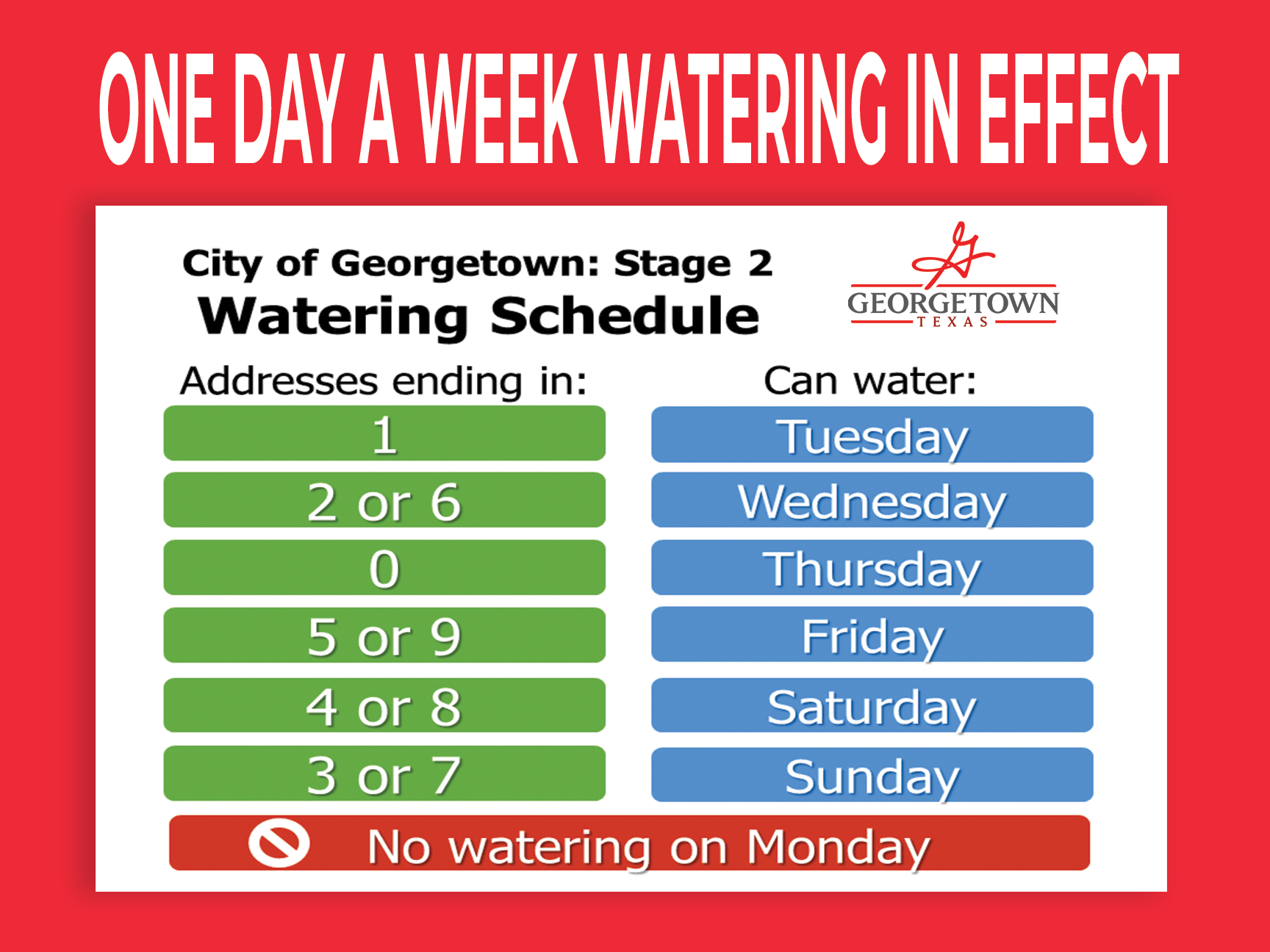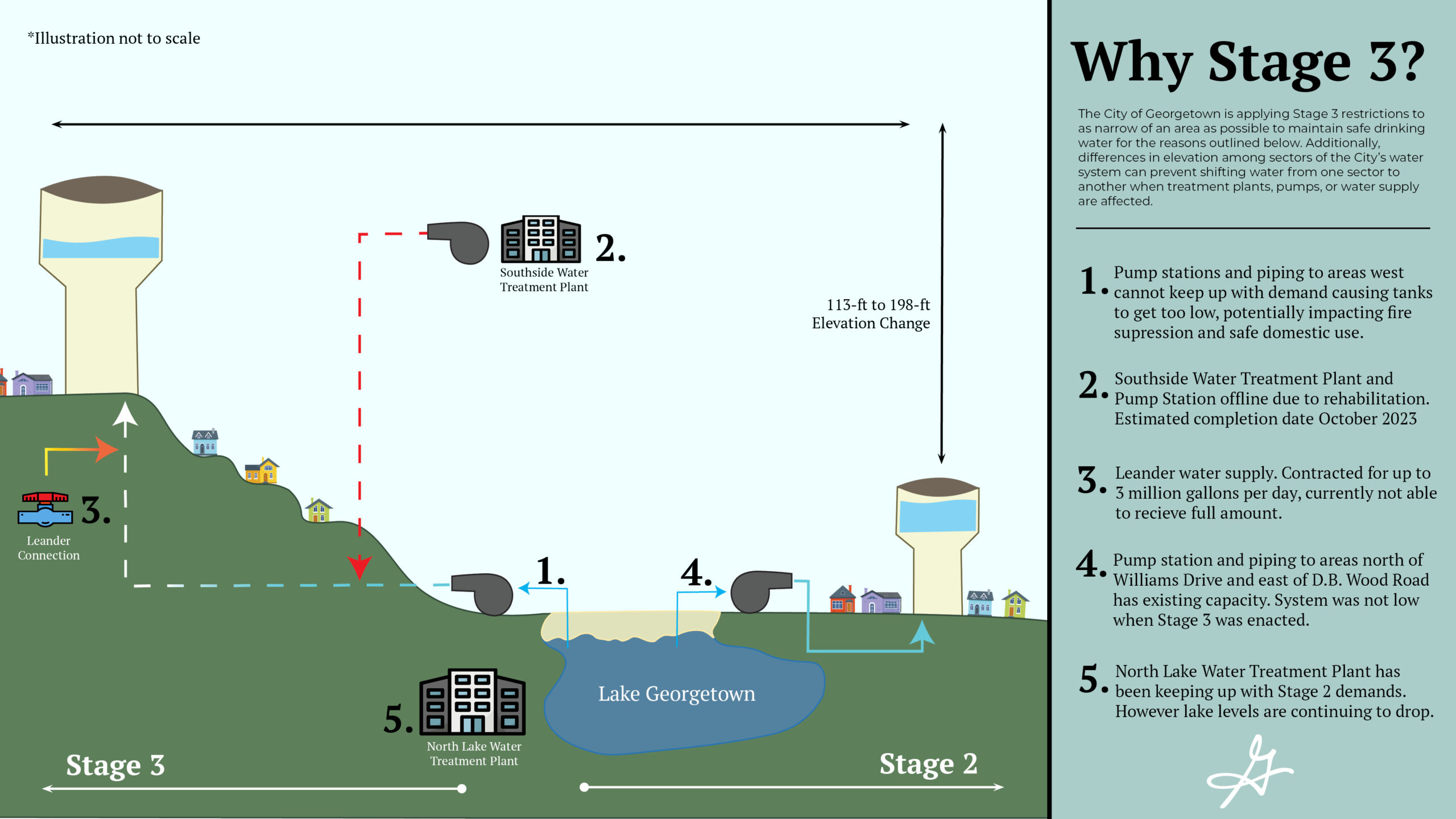Western portion of Georgetown water service area moved into Drought Stage 2
All Georgetown water customers on one-day-per-week watering schedule starting Sept. 29
Effective Friday, Sept. 29, 2023, all Georgetown water utility customers may return to the assigned, one-day-per-week outdoor watering schedule and other Drought Stage 2 restrictions.
Customers in the western side of the City of Georgetown’s service area – generally the areas west of D.B. Wood Road and southwest of Williams Drive – who have been under in Drought Stage 3 restrictions can water once per week on their assigned day starting Friday, Sept. 29, 2023. The Drought Stage 3 restrictions for the western portion of our water service area are being lifted because temperatures are starting to cool, usage has declined, and Georgetown is now receiving additional water from the City of Leander.
All Georgetown customers must adhere to the assigned, one-day-per-week outdoor watering schedule, so the City can continue to provide safe drinking water and avoid boil water notices. The one-day-per-week watering schedule is based on the location’s address: Click here to confirm your schedule. No one is exempted from these restrictions. Residents can report violations here.
“I cannot stress this enough: It is imperative that all Georgetown water customers water only on their day, so we make sure our system has enough pressure to provide safe drinking water,” City Manager David Morgan said.

| DROUGHT STAGE 2 RESTRICTIONS |
| One-day-per-week outdoor watering based on your address |
| No watering on Monday |
| No watering any day between 7 a.m. and 7 p.m. |
| Low-output watering methods – like handheld watering or using a watering can/bucket – are still allowed any day of the week. |
The City installed a temporary pump and started pulling additional water at its connection with the City of Leander Sept. 1. Georgetown has been consistently pulling an average of 1 to 1.5 million gallons per day from the connection since that time. The cities of both Georgetown and Leander have worked together to test the system and are confident this is a viable, sustainable solution moving forward.
The Southside Water Treatment Plant passed initial regulatory testing Sept. 22, giving the Texas Commission on Environmental Quality (TCEQ) up to 60 days to review the results and clear the plant to deliver water to customers. The City is working with TCEQ to significantly reduce their timeline.
“With a shift in lower temperatures and some rain, we’ve seen water demands on our system reduced,” Morgan said. “This, along with increased water from Leander, places us in a position to safely lift stage 3 restrictions.”
All City irrigation systems, which have been turned off since July 17, will revert to the one-day-per-week outdoor watering schedule.
Find more information on rebates, programming your controller how-to videos, and information on our water system at water.georgetown.org.
Frequently Asked Questions
Why did the City decide to put 35 percent of its customers — including customers in the ETJ, outside the ETJ, and within City limits — in Drought Stage 3 restrictions?
Several factors were involved in the City’s decision to put 35 percent of its customers — including customers in the ETJ, outside the ETJ, and within City limits — in Drought Stage 3 restrictions from July 17-Sept. 28.
- The Brazos River Authority moved into Drought Stage 2 restrictions for Lake Stillhouse and Lake Georgetown.
- The U.S. Drought Monitor moved Georgetown into an Exceptional Drought, (its highest level) on Aug. 24.
- Central Texas continues to see record-high, sustained temperatures, with 45 consecutive days of temperatures in triple digits.
- Gov. Greg Abbott on July 29 issued a disaster declaration for 37 counties, including Williamson County, because of the drought. Portions of Williamson County have not received any measurable rainfall in more than two months, according to the U.S. National Weather Service.
- The City was not receiving the full, contracted amount from the City of Leander, which is one of the primary sources of water for the affected area. The City installed a pump at the Leander connection to pull additional water Aug. 31. Securing the right size and quality of pump was challenging.
- The Southside Water Treatment Plant that also serves this area is offline for rehabilitation. Current estimates have the plant returning to full capacity in October 2023. The City is working with the contractor and regulatory agencies to expedite the project.
- The three pump stations servicing the affected area were unable to keep up with demand, and there are no alternatives to get more water to those pump stations for distribution. If pump stations cannot maintain pressure, it could lead to boil water notices.
- Georgetown water utility customers continued to water outside of the current restrictions. From July 17 through Aug. 31, the City had 16 days when usage was greater than 90 percent of our treatment capacity. During the summer months, 75 percent of the water produced each day by water treatment plants is used for lawn and landscape irrigation.
The City continues to monitor this unprecedented situation and will only implement water restrictions in a portion of our water service area as necessary to preserve the integrity of our drinking water system. Our primary goal is to maintain sufficient pressures for drinking water and other domestic uses.
The City initially chose Sept. 4 to end the Drought Stage 3 restrictions, because peak demand season for our water utility typically ends in August. Due to the record-setting heat, which was forecasted to continue into September, and prolonged drought, we are seeing higher demand for water and anticipate that to extend into September.
Why did the City extend Drought Stage 3 restrictions in only a portion of its service area?
We targeted the restrictions in response to the operational need to stabilize that specific area of our system. The other parts of the system benefit from different water sources that remained stable.
The primary water sources for the three pump stations serving the area previously in Drought Stage 3 restrictions are the Southside Water Treatment Plant, Northlake Plant, and the City of Leander. The Southside Plant is offline for rehabilitation; the Northlake Water Treatment Plant pumps that serve this area were running a maximum capacity; and the water from Leander was greatly reduced. There are no other alternative water sources for those three pump stations due to the topography of the area (unlike other parts of the City water system that do have alternatives). Once the Southside Water Treatment Plant comes back online, an additional 3 million gallons of capacity per day would be dedicated to this area. Additionally, the City was working to install a pump to pull additional water from the City of Leander. Until those projects were completed, the western area will remain the most stressed part of the water system.
These restrictions were necessary to maintain the integrity of the City’s drinking water system. The City Manager has broad authority to order water conservation measures necessary to protect the public health, safety, and welfare.
- Read about the City’s drought contingency regulations
- Read the City Manager’s order putting the Drought Stage 3 regulations into effect
- Read the City Manager’s Aug. 31 order extending the Drought Stage 3 restrictions
How much water is Georgetown pulling from the City of Leander?
The City of Georgetown is collecting water from the City of Leander. The amount of water coming from the City of Leander since July 13 was not sufficient to keep up with demand in the west or to get our western area out of Drought Stage 3.
We worked with Leander to develop both near- and long-term solutions to best serve all our customers and pull our customers out of Drought Stage 3. Georgetown installed a pump Sept. 1, which increased the amount of water we were able to pull from Leander. Georgetown has been pulling an average of 1 to 1.5 million gallons per day from Leander.
The challenges were compounded by the high demand for water for irrigation in the west and the Southside Treatment Plant, which also serves the western area, being offline for rehabilitation.
Why did the City of Georgetown not have a pump to pull more water from the City of Leander already?
The City of Leander is operating its system at a lower pressure level this summer, which the City of Georgetown didn’t learn about until mid-July. In order for Georgetown to pull an adequate amount of water from the Leander system operating a lower pressure, we had to purchase a new pump. The City had been trying to secure a viable pump since mid-July. The two pumps the City received and tested were not viable. We installed a third pump Sept. 1 and have been pulling additional water since. The combination of cooler temperatures, additional Leander water, and some rain have enabled us to lift stage 3.
How do surface water rights work, and why are neighboring cities not in the same restrictions we are?
Surface water rights for Lake Georgetown and Lake Stillhouse are contracted through the Brazos River Authority. Each municipality is unique with how many acre feet they have access to in the lakes per their contracts, as well as how many other sources of water (like wells, MUDS, etc.) they pull from to total their available capacities in their service areas. Watering restrictions look different for every City, and they are based on things like treatment capacity, usage, lake levels, and drought conditions.
The water supply issue is a regional challenge given the prolonged drought and the amount of water used to irrigate lawns in the summer months. More than a dozen cities in the surrounding area are under watering restrictions.
What about golf courses and car washes?
All six golf courses in Georgetown and Southwestern University use reclaimed water, as do some City maintained outdoor facilities, such as soccer fields. Sun City also uses reclaimed water for their communal facilities, in addition to their golf course. Car washes also recycle their water.
Why is the City continuing to approve new development when Drought Stage 3 restrictions are in place?
The state legislature has severely limited what municipalities can do to restrict growth. If developers can meet our development rules, they are entitled to develop their property. We are in the process of updating our development rules to match the vision we adopted in the 2030 Plan. Find out more about the 2030 plan here.
All new development pays impact fees, which help fund capital improvements to the City’s water infrastructure. Currently, those funds contribute to the $200 million, 44 million gallon-a-day Southlake Water Treatment Plant, half of this plant is scheduled to come online in 2025, and to the Northlake Water Treatment Plant expansion of 8 million gallons per day which should come online in the next two months. Learn more about water capital improvement projects here.
Is the City meeting its obligations to provide water within its service area?
The City is statutorily required to meet daily drinking water needs. (i.e., drinking water, showers, toilets, etc.). The City has capacity constraints s during the summer months when the vast majority of our drinking water is used to irrigate lawns. That is why the recent order was narrowly tailored to meet our immediate conservation needs.
Is hand-held watering allowed during these restrictions?
Yes, hand-held watering is allowed at any time during both Drought Stage 2 and Stage 3 restrictions. Hand-held watering includes holding your hose with a nozzle and watering with a watering can or bucket. You can hand-water anything, including your lawn, plants, and foundation.
What are we doing about new homes that need to install new sod?
Landscape install variances are not permitted in Drought Stage 3 restrictions, and sod is not required by our building code to allow homes to be sold or occupied within the City of Georgetown. We are allowing residential builders to provide us a letter of intent to install landscaping when water restrictions are lifted at their final inspection. Generally, we do not recommend laying down new sod during the heat of summer.
Why is the City flushing water out of hydrants?
TCEQ regulations require water utilities to flush water lines regularly to ensure safe drinking water. The water coming out of the fire hydrants should not be used for consumption or irrigation.










